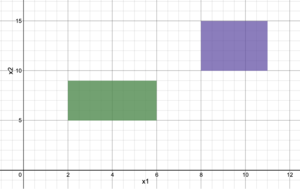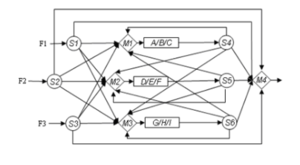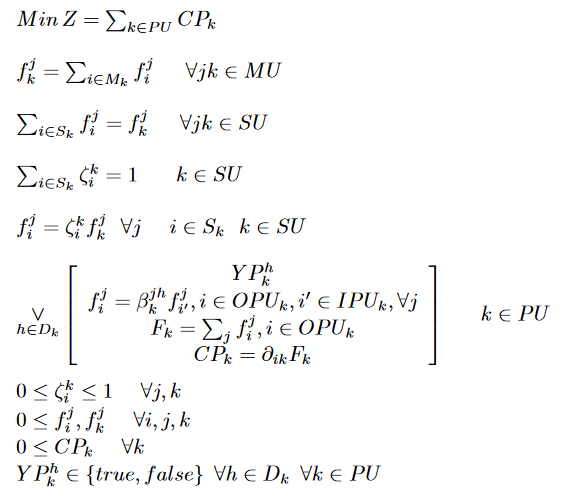Disjunctive inequalities
Authors: Derek Moore, Grant Logan, Matthew Dinh, Daniel Ladron (SYSEN 5800/CHEME 6800 Fall 2021)
Introduction
Disjunctive inequalities are a form of disjunctive constraints that can be applied to linear programming. Disjunctive constraints are applied in all disjunctive programming, which just refers to the use of logical constraints in linear inequalities, which include “Or,” And,” or "Complement of" statements.[1] In order to solve a disjunctive, the constraints have to be converted into mixed-integer programming (MIP) or mixed-inter linear programming (MILP) constraints, which is called disjunction. Disjunction involves the implementation of a binary variable to create a new set of constraints that can be solved easily. Two common methods for disjunction are the Big-M Reformulation and the Convex-Hull Reformulation.[2]
Method
General
When given a set of inequalities, such as , the disjunctive form is given by: [1] In order to turn the problem into a solvable MIP or MILP, logical constraints are created by using sufficiently large numbers, such as and , and a binary variable y for each inequality. This is shown below by , , and :
To set the binary variable to be mutually exclusive, the sum of the variables is set to 1 and the range is set to {0,1}.
Big-M Reformulation[1][2]

For the Big-M reformulation, a sufficiently large number, , is used to nullify one set of constraints. This is accomplished by adding or subtracting the term “” to the upper bound and lower bound constraints, respectively, with its respective binary variable. While choosing a large M value allows for isolation, the large value also yields poor relaxation of the model space.[3]
For example, given a solution space (shown graphically in Figure 1), to determine which of the solutions is optimal, the problem must be formulated such that one set of constraints is chosen. Using the Big-M Reformulation, the following MILP set would be obtained:
y Formulation
-y Formulation
Convex-Hull Reformulation[1][2]
Similar to the Big-M reformulation, the convex-hull reformulation uses a binary variable, y, to constrain the set of inequalities. The first step in converting the problem into a solvable MILP is breaking all variables into a set of variables, such as ( → + ). By adding these addition variables, it is possible to isolate what set of parameters provide for the optimal solution of the problem. Then, similar to the Big-M reformulation, a sufficiently large variable, M, is used to nullify the non-optimal variable set, such as and . For the problem show in Figure 1, the following variable constraints would be formulated:
y Formulation
-y Formulation
Formulation of the numerical constraints would then be implemented: y Formulation
-y Formulation
With the Convex-Hull transformation, the additional constraints confine the problem, such that a tighter (convex) solution space is examined compared to Big-M Formulation.[3]
Examples
A good example of solving a disjunctive inequalities is using the reformulation methods below:
Using Big-M Formulation:
Using Convex-hull Formulation:
Applications

GDP formulations can be used to identify real world problems. Below in Figure 2, shows a wastewater network that removes pollutants from its mixture. The task is to figure out the total cost to discharge the pollution.
This wastewater system can be reformulated into a non-convex General Disjunction Programming problem shown below:
Conclusion
Disjunctive inequalities can be used to generate all valid inequalities for an integer program. A simple disjunctive procedure can be used to generate all valid inequalities for a 0 or 1 mixed-integer program. It could be shown that to obtain the convex hull of a 0 or 1 mixed-integer program, it suffices to take the convex hull of each 0 or 1 variable at a time. Another method to reformulate a disjunctive inequality is to implement the Big-M method which generates a much smaller MILP/MINLP with a tighter relaxation than the convex-hull method.
References
- ↑ 1.0 1.1 1.2 1.3 E. Balas, “Disjunctive programming,” Annals of Discr. Math., vol. 5, pp. 6-11, 1979.
- ↑ 2.0 2.1 2.2 Pedro M. Castro and Ignacio E. Grossmann. 'Generalized Disjunctive Programming as a Systematic Modeling Framework to Derive Scheduling Formulations." 2012 51 (16), 5781-5792 DOI: 10.1021/ie2030486
- ↑ 3.0 3.1 You, Frengqi. (2021). "Mixed-Integer Linear Programming."
- ↑ L.A. Wolsey, Integer Programming, pp 130 - 133. Wiley, 1998.
- ↑ L.T. Biegler, I.E. Grossmann, A.W. Westerberg, Systematic Methods of Chemical Process Design. Prentice Hall Press, 1997.
- ↑ Grossmann, Ignacio E., and Juan P. Ruiz. Generalized Disjunctive Programming: A framework for formulation and alternative algorithms for MINLP optimization, Mixed Integer Nonlinear Programming, Springer New York, 2012.




























![{\displaystyle [x_{1}-x_{2}\leq -1]\lor [-x_{1}+x_{2}\leq -1]}](https://wikimedia.org/api/rest_v1/media/math/render/svg/494d517822939e39738249c684daaa91c75ec10e)










